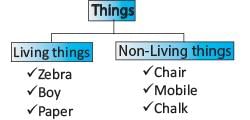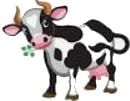All Exams >
Grade 1 >
Science & Technology for Grade 1 >
All Questions
All questions of Living Things and Their Growth for Grade 1 Exam
Which of the following things can not move by itself?- a)Bus
- b)Bird
- c)Fish
- d)Boy
Correct answer is option 'A'. Can you explain this answer?
Which of the following things can not move by itself?
a)
Bus
b)
Bird
c)
Fish
d)
Boy

|
Vinayak Agarwal Class 2n answered |
All are living things but bus is non living thing
Why do animals move from place to place?
(i) To look for food
(ii) To look for water
(iii) To look away from danger.
(iv) To look for shelter
- a)Only (iv)
- b)(i), (ii), (iii) and (iv)
- c)Only (ii), (iii) and (iv)
- d)Only (i) and (ii)
Correct answer is option 'B'. Can you explain this answer?
Why do animals move from place to place?
(i) To look for food
(ii) To look for water
(iii) To look away from danger.
(iv) To look for shelter
(i) To look for food
(ii) To look for water
(iii) To look away from danger.
(iv) To look for shelter
a)
Only (iv)
b)
(i), (ii), (iii) and (iv)
c)
Only (ii), (iii) and (iv)
d)
Only (i) and (ii)
|
|
Kiran Tiwari answered |
**Explanation:**
Animals move from place to place for various reasons. Let's examine each option to understand why animals engage in such movements.
**(i) To look for food:**
- Animals need food to survive and grow.
- They move to find sources of food such as plants, other animals, or carrion.
- The availability of food can vary in different areas, so animals may need to move to find a sufficient food supply.
**(ii) To look for water:**
- Water is essential for animals to stay hydrated and carry out various bodily functions.
- They move to locate water sources like rivers, lakes, or watering holes.
- In areas with limited water availability, animals may need to migrate to find water during dry seasons.
**(iii) To look away from danger:**
- Animals have a natural instinct to avoid danger and protect themselves.
- They move away from areas or situations that pose a threat to their safety.
- This could involve fleeing from predators, escaping from fires, or avoiding other harmful environmental conditions.
**(iv) To look for shelter:**
- Animals need shelter to protect themselves from extreme weather conditions, predators, and other dangers.
- They move to find suitable places to build nests, burrows, or dens.
- The availability of shelter can vary, and animals may need to relocate to find safer and more suitable habitats.
Based on the explanations above, it is clear that animals move for all the given reasons - to look for food, water, to avoid danger, and to find shelter. Therefore, the correct answer is option **(d) (i), (ii), (iii), and (iv)**.
Animals move from place to place for various reasons. Let's examine each option to understand why animals engage in such movements.
**(i) To look for food:**
- Animals need food to survive and grow.
- They move to find sources of food such as plants, other animals, or carrion.
- The availability of food can vary in different areas, so animals may need to move to find a sufficient food supply.
**(ii) To look for water:**
- Water is essential for animals to stay hydrated and carry out various bodily functions.
- They move to locate water sources like rivers, lakes, or watering holes.
- In areas with limited water availability, animals may need to migrate to find water during dry seasons.
**(iii) To look away from danger:**
- Animals have a natural instinct to avoid danger and protect themselves.
- They move away from areas or situations that pose a threat to their safety.
- This could involve fleeing from predators, escaping from fires, or avoiding other harmful environmental conditions.
**(iv) To look for shelter:**
- Animals need shelter to protect themselves from extreme weather conditions, predators, and other dangers.
- They move to find suitable places to build nests, burrows, or dens.
- The availability of shelter can vary, and animals may need to relocate to find safer and more suitable habitats.
Based on the explanations above, it is clear that animals move for all the given reasons - to look for food, water, to avoid danger, and to find shelter. Therefore, the correct answer is option **(d) (i), (ii), (iii), and (iv)**.
A Plant is different from rocks because a plant can ____.- a)grow
- b)breathe
- c)reproduce
- d)All of these
Correct answer is option 'D'. Can you explain this answer?
A Plant is different from rocks because a plant can ____.
a)
grow
b)
breathe
c)
reproduce
d)
All of these
|
|
Jaideep Yadav answered |
Introduction:
Plants and rocks are two different things found in nature. While rocks are non-living and inert, plants are living organisms that possess various characteristics that differentiate them from rocks. In this context, the correct answer is option 'D', which states that a plant can grow, breathe, and reproduce. Let's explore each of these characteristics in detail.
Explanation:
1. Growth:
- One of the key characteristics that differentiate plants from rocks is their ability to grow.
- Plants have specialized structures, such as stems, leaves, and roots, which allow them to increase in size and develop new tissues.
- Through a process called photosynthesis, plants convert sunlight, water, and carbon dioxide into energy, which fuels their growth.
- As plants grow, they develop new leaves, branches, flowers, and sometimes even fruits.
2. Breathing:
- Another significant difference between plants and rocks is that plants can breathe or exchange gases with their environment.
- Plants have tiny openings called stomata on their leaves and stems, which allow them to take in carbon dioxide from the air and release oxygen during photosynthesis.
- This process of exchanging gases is crucial for the survival of plants and also contributes to the oxygen levels in the atmosphere.
3. Reproduction:
- Reproduction is a fundamental characteristic of living organisms, and plants have the ability to reproduce.
- Plants can reproduce in two main ways: sexual reproduction and asexual reproduction.
- Sexual reproduction involves the fusion of male and female reproductive cells, resulting in the formation of seeds or fruits.
- Asexual reproduction, on the other hand, involves the production of new plants from vegetative parts, such as stems, leaves, or roots.
- By reproducing, plants ensure the continuity of their species and contribute to the biodiversity of the ecosystem.
Conclusion:
Plants possess the unique ability to grow, breathe, and reproduce, which distinguishes them from non-living objects like rocks. These characteristics enable plants to interact with their environment, respond to stimuli, and contribute to the balance of the ecosystem. Understanding these differences helps us appreciate the complexity and diversity of the natural world.
Plants and rocks are two different things found in nature. While rocks are non-living and inert, plants are living organisms that possess various characteristics that differentiate them from rocks. In this context, the correct answer is option 'D', which states that a plant can grow, breathe, and reproduce. Let's explore each of these characteristics in detail.
Explanation:
1. Growth:
- One of the key characteristics that differentiate plants from rocks is their ability to grow.
- Plants have specialized structures, such as stems, leaves, and roots, which allow them to increase in size and develop new tissues.
- Through a process called photosynthesis, plants convert sunlight, water, and carbon dioxide into energy, which fuels their growth.
- As plants grow, they develop new leaves, branches, flowers, and sometimes even fruits.
2. Breathing:
- Another significant difference between plants and rocks is that plants can breathe or exchange gases with their environment.
- Plants have tiny openings called stomata on their leaves and stems, which allow them to take in carbon dioxide from the air and release oxygen during photosynthesis.
- This process of exchanging gases is crucial for the survival of plants and also contributes to the oxygen levels in the atmosphere.
3. Reproduction:
- Reproduction is a fundamental characteristic of living organisms, and plants have the ability to reproduce.
- Plants can reproduce in two main ways: sexual reproduction and asexual reproduction.
- Sexual reproduction involves the fusion of male and female reproductive cells, resulting in the formation of seeds or fruits.
- Asexual reproduction, on the other hand, involves the production of new plants from vegetative parts, such as stems, leaves, or roots.
- By reproducing, plants ensure the continuity of their species and contribute to the biodiversity of the ecosystem.
Conclusion:
Plants possess the unique ability to grow, breathe, and reproduce, which distinguishes them from non-living objects like rocks. These characteristics enable plants to interact with their environment, respond to stimuli, and contribute to the balance of the ecosystem. Understanding these differences helps us appreciate the complexity and diversity of the natural world.
Direction : Select the odd one out.
- a)Truck
- b)Wood
- c)Rock
- d)Water
Correct answer is option 'A'. Can you explain this answer?
Direction : Select the odd one out.
a)
Truck
b)
Wood
c)
Rock
d)
Water

|
Vikash Singh answered |
This answer is wrong truck will be right answer
Which of the following belongs to the group made by the other?- a)Fish
- b)Flower
- c)Cup
- d)Rabbit
Correct answer is option 'C'. Can you explain this answer?
Which of the following belongs to the group made by the other?
a)
Fish
b)
Flower
c)
Cup
d)
Rabbit
|
|
Amit Khanna answered |
Cup is not natural but made by others.
Non-green plants such as cannot make their own food.- a)rose
- b)marigold
- c)mushrooms
- d)jasmine
Correct answer is option 'C'. Can you explain this answer?
Non-green plants such as cannot make their own food.
a)
rose
b)
marigold
c)
mushrooms
d)
jasmine
|
|
Amit Khanna answered |
Mushroom are nongreen plants and are not able to make their food themselves.
It is living,
It is living,
I know why!
I know why!
It breathes and ____ and ____
It breathes and ____ and ____
It's alive
It's alive
State what does it do:- a)Grows and changes
- b)Feel and run
- c)Sleep and move
- d)All of these
Correct answer is option 'D'. Can you explain this answer?
It is living,
It is living,
I know why!
I know why!
It breathes and ____ and ____
It breathes and ____ and ____
It's alive
It's alive
State what does it do:
It is living,
I know why!
I know why!
It breathes and ____ and ____
It breathes and ____ and ____
It's alive
It's alive
State what does it do:
a)
Grows and changes
b)
Feel and run
c)
Sleep and move
d)
All of these
|
|
Aman Banerjee answered |
Understanding Life Characteristics
When we talk about living things, we often refer to certain characteristics that define life. The correct answer, option 'D', emphasizes that living organisms grow and change, feel and run, sleep and move. Let's break down each aspect:
Grows and Changes
- Living organisms undergo growth, which means they increase in size and complexity over time.
- They also experience changes in their life cycle, such as development from infancy to adulthood.
Feel and Run
- Living beings have the ability to sense their environment. This sensitivity allows them to react to stimuli, such as light, sound, and temperature.
- Many organisms, including animals, can move from one place to another, which is essential for finding food, escaping danger, and exploring their surroundings.
Sleep and Move
- Sleep is a crucial part of life for many organisms. It helps them to rest, recover, and maintain overall health.
- Movement is not limited to animals; even plants exhibit movement, like bending toward light or opening and closing flowers.
Conclusion
Overall, the characteristics of living things encompass a wide range of activities that are vital for survival. Therefore, the ability to grow, feel, run, sleep, and move are all essential elements that confirm that something is indeed alive. This understanding helps us appreciate the complexity and beauty of life around us.
When we talk about living things, we often refer to certain characteristics that define life. The correct answer, option 'D', emphasizes that living organisms grow and change, feel and run, sleep and move. Let's break down each aspect:
Grows and Changes
- Living organisms undergo growth, which means they increase in size and complexity over time.
- They also experience changes in their life cycle, such as development from infancy to adulthood.
Feel and Run
- Living beings have the ability to sense their environment. This sensitivity allows them to react to stimuli, such as light, sound, and temperature.
- Many organisms, including animals, can move from one place to another, which is essential for finding food, escaping danger, and exploring their surroundings.
Sleep and Move
- Sleep is a crucial part of life for many organisms. It helps them to rest, recover, and maintain overall health.
- Movement is not limited to animals; even plants exhibit movement, like bending toward light or opening and closing flowers.
Conclusion
Overall, the characteristics of living things encompass a wide range of activities that are vital for survival. Therefore, the ability to grow, feel, run, sleep, and move are all essential elements that confirm that something is indeed alive. This understanding helps us appreciate the complexity and beauty of life around us.
Which one of the following is true about the non-living things?- a)Non-living things have ability to think.
- b)Non-living things eat food.
- c)Non-living things need water to survive.
- d)Non-living things do not need air.
Correct answer is option 'D'. Can you explain this answer?
Which one of the following is true about the non-living things?
a)
Non-living things have ability to think.
b)
Non-living things eat food.
c)
Non-living things need water to survive.
d)
Non-living things do not need air.
|
|
Diya Chakraborty answered |
Non-Living Things and Their Characteristics
Non-living things are those that do not possess life or living characteristics. They are made up of matter and do not have the ability to grow, reproduce, or respond to their environment. Let's look at some of the characteristics of non-living things:
1. No ability to think
Non-living things do not have a brain or nervous system, so they cannot think or feel emotions. They do not have the ability to make decisions or solve problems.
2. No need to eat food
Non-living things do not need to eat food to survive. They do not have a metabolism or digestive system, so they cannot break down food for energy.
3. No need for water
Non-living things do not need water to survive. They do not have cells or tissues that require hydration.
4. No need for air
Non-living things also do not need air to survive. They do not have a respiratory system or cells that require oxygen.
In conclusion, option 'D' is the correct answer as non-living things do not need air.
Non-living things are those that do not possess life or living characteristics. They are made up of matter and do not have the ability to grow, reproduce, or respond to their environment. Let's look at some of the characteristics of non-living things:
1. No ability to think
Non-living things do not have a brain or nervous system, so they cannot think or feel emotions. They do not have the ability to make decisions or solve problems.
2. No need to eat food
Non-living things do not need to eat food to survive. They do not have a metabolism or digestive system, so they cannot break down food for energy.
3. No need for water
Non-living things do not need water to survive. They do not have cells or tissues that require hydration.
4. No need for air
Non-living things also do not need air to survive. They do not have a respiratory system or cells that require oxygen.
In conclusion, option 'D' is the correct answer as non-living things do not need air.
A boy needs air, food and _____ to stay alive.- a)toys
- b)clothes
- c)water
- d)chocolate
Correct answer is option 'C'. Can you explain this answer?
A boy needs air, food and _____ to stay alive.
a)
toys
b)
clothes
c)
water
d)
chocolate
|
|
Rashi Tiwari answered |
Air, Food, and Water: The Essentials for Survival
In order to stay alive, living organisms require certain basic necessities. These essentials provide the energy and sustenance needed for survival. Among these essentials, air, food, and water are the most crucial for the survival of human beings.
Air is a mixture of gases, primarily oxygen and nitrogen, which is essential for sustaining life. When we breathe, our bodies take in oxygen from the air and release carbon dioxide as a waste product. Oxygen is necessary for the process of respiration, where energy is produced in our cells. Without air, our bodies would not receive the oxygen needed to survive.
Food provides the necessary nutrients and energy for our bodies to function properly. It contains macronutrients, such as carbohydrates, proteins, and fats, as well as micronutrients, including vitamins and minerals. These nutrients are essential for growth, repair, and maintenance of our body tissues. Without food, our bodies would not have the fuel needed to carry out vital functions.
Water is often referred to as the elixir of life due to its vital role in sustaining all forms of life. Our bodies are composed of approximately 60% water, and it is involved in various bodily functions. Water helps regulate body temperature, aids in digestion, transports nutrients and waste products, and lubricates joints. It is also essential for maintaining proper hydration levels. Without water, our bodies would quickly dehydrate, leading to severe health complications and eventually death.
In summary, air, food, and water are the three essential elements required for human survival. Air provides the necessary oxygen for respiration, food supplies the nutrients and energy for bodily functions, and water maintains hydration and facilitates crucial bodily processes. Without these essentials, the human body would cease to function, highlighting their fundamental importance in sustaining life.
Introduction
In order to stay alive, living organisms require certain basic necessities. These essentials provide the energy and sustenance needed for survival. Among these essentials, air, food, and water are the most crucial for the survival of human beings.
Air: The Breath of Life
Air is a mixture of gases, primarily oxygen and nitrogen, which is essential for sustaining life. When we breathe, our bodies take in oxygen from the air and release carbon dioxide as a waste product. Oxygen is necessary for the process of respiration, where energy is produced in our cells. Without air, our bodies would not receive the oxygen needed to survive.
Food: Fuel for the Body
Food provides the necessary nutrients and energy for our bodies to function properly. It contains macronutrients, such as carbohydrates, proteins, and fats, as well as micronutrients, including vitamins and minerals. These nutrients are essential for growth, repair, and maintenance of our body tissues. Without food, our bodies would not have the fuel needed to carry out vital functions.
Water: The Elixir of Life
Water is often referred to as the elixir of life due to its vital role in sustaining all forms of life. Our bodies are composed of approximately 60% water, and it is involved in various bodily functions. Water helps regulate body temperature, aids in digestion, transports nutrients and waste products, and lubricates joints. It is also essential for maintaining proper hydration levels. Without water, our bodies would quickly dehydrate, leading to severe health complications and eventually death.
Conclusion
In summary, air, food, and water are the three essential elements required for human survival. Air provides the necessary oxygen for respiration, food supplies the nutrients and energy for bodily functions, and water maintains hydration and facilitates crucial bodily processes. Without these essentials, the human body would cease to function, highlighting their fundamental importance in sustaining life.
All living things produce other living things of their own- a)kind
- b)different
- c)hatch
- d)birth
Correct answer is option 'A'. Can you explain this answer?
All living things produce other living things of their own
a)
kind
b)
different
c)
hatch
d)
birth
|
|
Anagha Joshi answered |
Introduction:
All living things have the ability to reproduce and produce offspring of their own kind. This is a fundamental characteristic of life and is essential for the continuation of species.
Explanation:
1. Reproduction:
Reproduction is the biological process by which new individuals of the same kind are produced. It is the mechanism through which living organisms ensure the survival of their species. Reproduction can occur in two main ways: asexual and sexual reproduction.
2. Asexual Reproduction:
Asexual reproduction is a mode of reproduction in which offspring are produced by a single parent, without the involvement of gametes (sex cells) or the fusion of genetic material. This type of reproduction results in the production of genetically identical offspring, also known as clones. Some common methods of asexual reproduction include budding, fragmentation, and binary fission.
3. Sexual Reproduction:
Sexual reproduction is a mode of reproduction that involves the fusion of gametes from two parents, resulting in the production of genetically diverse offspring. In sexual reproduction, two individuals contribute genetic material to form a new individual. This process involves the formation of specialized cells called gametes, which are produced by the reproductive organs. The male gamete is called sperm, and the female gamete is called an egg or ovum. The fusion of these gametes during fertilization leads to the formation of a zygote, which develops into a new individual.
4. Offspring of Their Own Kind:
When living things reproduce, they produce offspring that belong to the same species or kind as themselves. For example, dogs give birth to puppies, cats give birth to kittens, and birds hatch eggs that contain baby birds of their own kind. This ensures the continuation of the species and the preservation of the genetic characteristics of that particular kind.
Conclusion:
In conclusion, all living things have the ability to produce other living things of their own kind through the process of reproduction. Whether through asexual or sexual reproduction, the production of offspring ensures the continuation and survival of the species. This characteristic is one of the defining features of life and is shared by all living organisms.
All living things have the ability to reproduce and produce offspring of their own kind. This is a fundamental characteristic of life and is essential for the continuation of species.
Explanation:
1. Reproduction:
Reproduction is the biological process by which new individuals of the same kind are produced. It is the mechanism through which living organisms ensure the survival of their species. Reproduction can occur in two main ways: asexual and sexual reproduction.
2. Asexual Reproduction:
Asexual reproduction is a mode of reproduction in which offspring are produced by a single parent, without the involvement of gametes (sex cells) or the fusion of genetic material. This type of reproduction results in the production of genetically identical offspring, also known as clones. Some common methods of asexual reproduction include budding, fragmentation, and binary fission.
3. Sexual Reproduction:
Sexual reproduction is a mode of reproduction that involves the fusion of gametes from two parents, resulting in the production of genetically diverse offspring. In sexual reproduction, two individuals contribute genetic material to form a new individual. This process involves the formation of specialized cells called gametes, which are produced by the reproductive organs. The male gamete is called sperm, and the female gamete is called an egg or ovum. The fusion of these gametes during fertilization leads to the formation of a zygote, which develops into a new individual.
4. Offspring of Their Own Kind:
When living things reproduce, they produce offspring that belong to the same species or kind as themselves. For example, dogs give birth to puppies, cats give birth to kittens, and birds hatch eggs that contain baby birds of their own kind. This ensures the continuation of the species and the preservation of the genetic characteristics of that particular kind.
Conclusion:
In conclusion, all living things have the ability to produce other living things of their own kind through the process of reproduction. Whether through asexual or sexual reproduction, the production of offspring ensures the continuation and survival of the species. This characteristic is one of the defining features of life and is shared by all living organisms.
Which of the following object wasnever a part of living beings.- a)Clay Pot
- b)Pepper
- c)Paper
- d)Wooden chair
Correct answer is option 'A'. Can you explain this answer?
Which of the following object wasnever a part of living beings.
a)
Clay Pot
b)
Pepper
c)
Paper
d)
Wooden chair
|
|
Anoushka Choudhary answered |
Explanation:
The correct answer is option 'A', which states that a clay pot was never a part of living beings. Let's understand why this is the correct answer.
Living Beings:
Living beings are organisms that have the ability to perform vital functions such as growth, reproduction, and response to stimuli. They are made up of cells and have characteristics like respiration, metabolism, and the ability to adapt to their environment.
Non-living Objects:
Non-living objects, on the other hand, do not possess these characteristics. They are not capable of growth, reproduction, or response to stimuli. Non-living objects are made up of materials like wood, metal, clay, etc., and they do not have cells or any form of biological structure.
Now, let's analyze the options given in the question:
- Clay Pot: A clay pot is a non-living object that is made by shaping clay and firing it at high temperatures. It does not possess any characteristics of a living being, such as cells or the ability to perform vital functions. Therefore, option 'A' is correct.
- Pepper: Pepper is a spice that is derived from the dried fruit of the pepper plant. While the pepper plant is a living being, the dried fruit used as a spice is a non-living object. However, since the question asks about the object itself and not the source, pepper can be considered a non-living object.
- Paper: Paper is a thin material made from cellulose fibers derived from wood. While wood is derived from living trees, the process of making paper involves breaking down the wood fibers and removing all living components. Therefore, paper can be considered a non-living object.
- Wooden Chair: A wooden chair is made from wood, which is derived from living trees. However, like paper, the process of making a wooden chair involves shaping and treating the wood, removing all living components. Therefore, a wooden chair can be considered a non-living object.
In conclusion, option 'A' (Clay Pot) is the correct answer as it is the only option that is a non-living object and was never a part of a living being.
The correct answer is option 'A', which states that a clay pot was never a part of living beings. Let's understand why this is the correct answer.
Living Beings:
Living beings are organisms that have the ability to perform vital functions such as growth, reproduction, and response to stimuli. They are made up of cells and have characteristics like respiration, metabolism, and the ability to adapt to their environment.
Non-living Objects:
Non-living objects, on the other hand, do not possess these characteristics. They are not capable of growth, reproduction, or response to stimuli. Non-living objects are made up of materials like wood, metal, clay, etc., and they do not have cells or any form of biological structure.
Now, let's analyze the options given in the question:
- Clay Pot: A clay pot is a non-living object that is made by shaping clay and firing it at high temperatures. It does not possess any characteristics of a living being, such as cells or the ability to perform vital functions. Therefore, option 'A' is correct.
- Pepper: Pepper is a spice that is derived from the dried fruit of the pepper plant. While the pepper plant is a living being, the dried fruit used as a spice is a non-living object. However, since the question asks about the object itself and not the source, pepper can be considered a non-living object.
- Paper: Paper is a thin material made from cellulose fibers derived from wood. While wood is derived from living trees, the process of making paper involves breaking down the wood fibers and removing all living components. Therefore, paper can be considered a non-living object.
- Wooden Chair: A wooden chair is made from wood, which is derived from living trees. However, like paper, the process of making a wooden chair involves shaping and treating the wood, removing all living components. Therefore, a wooden chair can be considered a non-living object.
In conclusion, option 'A' (Clay Pot) is the correct answer as it is the only option that is a non-living object and was never a part of a living being.
Match the column (I) with column (II)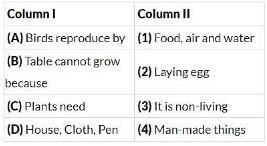
- a)A-1, B-2, C-3, D-4
- b)A-4, B-3, C-2, D-1
- c)A-2, B-3, C-1, D-4
- d)A-3, B-1, C-2, D-4
Correct answer is option 'C'. Can you explain this answer?
Match the column (I) with column (II)

a)
A-1, B-2, C-3, D-4
b)
A-4, B-3, C-2, D-1
c)
A-2, B-3, C-1, D-4
d)
A-3, B-1, C-2, D-4
|
|
Amit Khanna answered |
Birds reproduce by laying eggs. Table is man-made things. Plant need food, air and water. House cloth and pen are non living things.
Living things will die if they do not get:- a)Air
- b)Water
- c)Food
- d)All of these
Correct answer is option 'D'. Can you explain this answer?
Living things will die if they do not get:
a)
Air
b)
Water
c)
Food
d)
All of these
|
|
Anshul Das answered |
Importance of Air, Water, and Food for Living Things
Living organisms, including humans, animals, and plants, require a combination of air, water, and food to survive. Each of these elements plays a critical role in sustaining life.
Air
- Air is essential for respiration.
- Living things, especially animals, need oxygen from the air to convert food into energy.
- Plants utilize carbon dioxide from the air during photosynthesis to produce their food and release oxygen.
Water
- Water is vital for all living organisms.
- It acts as a solvent, helping to transport nutrients and waste within the body.
- Water is necessary for various biochemical reactions, including digestion and metabolism.
- Plants require water for photosynthesis and to maintain their structure through turgor pressure.
Food
- Food provides the necessary nutrients for growth, energy, and maintenance of bodily functions.
- It contains essential vitamins and minerals that support overall health.
- Different organisms have varied dietary needs, but all require food to survive.
Conclusion
In summary, air, water, and food are interconnected necessities for life. Without any one of these elements, living things cannot thrive. This is why the correct answer to the question is option 'D': all of these are essential for the survival of living beings. Understanding the importance of these basic needs helps us appreciate the delicate balance of ecosystems and the interdependence of life on Earth.
Living organisms, including humans, animals, and plants, require a combination of air, water, and food to survive. Each of these elements plays a critical role in sustaining life.
Air
- Air is essential for respiration.
- Living things, especially animals, need oxygen from the air to convert food into energy.
- Plants utilize carbon dioxide from the air during photosynthesis to produce their food and release oxygen.
Water
- Water is vital for all living organisms.
- It acts as a solvent, helping to transport nutrients and waste within the body.
- Water is necessary for various biochemical reactions, including digestion and metabolism.
- Plants require water for photosynthesis and to maintain their structure through turgor pressure.
Food
- Food provides the necessary nutrients for growth, energy, and maintenance of bodily functions.
- It contains essential vitamins and minerals that support overall health.
- Different organisms have varied dietary needs, but all require food to survive.
Conclusion
In summary, air, water, and food are interconnected necessities for life. Without any one of these elements, living things cannot thrive. This is why the correct answer to the question is option 'D': all of these are essential for the survival of living beings. Understanding the importance of these basic needs helps us appreciate the delicate balance of ecosystems and the interdependence of life on Earth.
How many living things are these?
Bus, Rock, Fish, Leaves door, cow, spoon, cloth
- a)3
- b)4
- c)2
- d)6
Correct answer is option 'A'. Can you explain this answer?
How many living things are these?
Bus, Rock, Fish, Leaves door, cow, spoon, cloth
Bus, Rock, Fish, Leaves door, cow, spoon, cloth
a)
3
b)
4
c)
2
d)
6
|
|
Ipsita Sarkar answered |
Identifying Living Things
Living things are organisms that have the following characteristics:
- They need food, water, and air to survive.
- They grow and develop.
- They can reproduce.
- They respond to stimuli.
- They have the ability to move.
- They have cells.
Using these characteristics, we can identify which items in the list provided are living things.
- Bus - Not a living thing. It does not have cells, it does not grow or develop, and it does not need food, water, or air to survive.
- Rock - Not a living thing. Rocks do not have cells, they do not grow or develop, and they do not need food, water, or air to survive.
- Fish - Living thing. Fish have cells, they grow and develop, they need food, water, and air to survive, they can reproduce, they respond to stimuli, and they have the ability to move.
- Leaves - Living thing. Leaves have cells, they grow and develop, they need food, water, and air to survive, they can reproduce, they respond to stimuli, and they do not have the ability to move.
- Door - Not a living thing. Doors do not have cells, they do not grow or develop, and they do not need food, water, or air to survive.
- Cow - Living thing. Cows have cells, they grow and develop, they need food, water, and air to survive, they can reproduce, they respond to stimuli, and they have the ability to move.
- Spoon - Not a living thing. Spoons do not have cells, they do not grow or develop, and they do not need food, water, or air to survive.
- Cloth - Not a living thing. Cloth does not have cells, it does not grow or develop, and it does not need food, water, or air to survive.
Therefore, there are three living things in the list: fish, leaves, and cow. The correct answer is option A.
Living things are organisms that have the following characteristics:
- They need food, water, and air to survive.
- They grow and develop.
- They can reproduce.
- They respond to stimuli.
- They have the ability to move.
- They have cells.
Using these characteristics, we can identify which items in the list provided are living things.
- Bus - Not a living thing. It does not have cells, it does not grow or develop, and it does not need food, water, or air to survive.
- Rock - Not a living thing. Rocks do not have cells, they do not grow or develop, and they do not need food, water, or air to survive.
- Fish - Living thing. Fish have cells, they grow and develop, they need food, water, and air to survive, they can reproduce, they respond to stimuli, and they have the ability to move.
- Leaves - Living thing. Leaves have cells, they grow and develop, they need food, water, and air to survive, they can reproduce, they respond to stimuli, and they do not have the ability to move.
- Door - Not a living thing. Doors do not have cells, they do not grow or develop, and they do not need food, water, or air to survive.
- Cow - Living thing. Cows have cells, they grow and develop, they need food, water, and air to survive, they can reproduce, they respond to stimuli, and they have the ability to move.
- Spoon - Not a living thing. Spoons do not have cells, they do not grow or develop, and they do not need food, water, or air to survive.
- Cloth - Not a living thing. Cloth does not have cells, it does not grow or develop, and it does not need food, water, or air to survive.
Therefore, there are three living things in the list: fish, leaves, and cow. The correct answer is option A.
Which of these is NOT correct?
- a)Non-living things do not grow
- b)Non-living things have emotions
- c)Non-living things do not breathe
- d)Non-living things do not reproduce
Correct answer is option 'B'. Can you explain this answer?
Which of these is NOT correct?
a)
Non-living things do not grow
b)
Non-living things have emotions
c)
Non-living things do not breathe
d)
Non-living things do not reproduce
|
|
Shreya Nambiar answered |
Non-living things do not have emotions
Non-living things do not have the ability to experience emotions. Emotions are complex psychological responses that require a conscious mind, which non-living things do not possess. Here are some reasons why non-living things do not have emotions:
Lack of consciousness
Non-living things lack consciousness, which is necessary for experiencing emotions. Emotions are subjective experiences that require self-awareness and the ability to perceive and interpret situations in a certain way. Since non-living things do not have a conscious mind, they cannot have emotions.
Absence of physiological responses
Emotions are often accompanied by physiological responses such as changes in heart rate, breathing, and hormone levels. Non-living things do not have physiological systems that can respond to emotional stimuli in this way. They do not have the ability to feel fear, joy, sadness, or any other emotions.
Dependence on external forces
Non-living things do not have the capacity to generate emotions internally. They do not have the ability to think, feel, or react to their environment based on their own internal states. Instead, they are passive objects that respond to external forces such as physical laws and human manipulation.
In conclusion, non-living things do not have emotions because they lack consciousness, physiological responses, and the ability to generate emotions internally. Emotions are a complex aspect of human psychology that are not present in non-living objects.
What would happen if living things did not get food?- a)It will be stronger
- b)It will die
- c)It will be reproduce
- d)It will be remain healthy
Correct answer is option 'B'. Can you explain this answer?
What would happen if living things did not get food?
a)
It will be stronger
b)
It will die
c)
It will be reproduce
d)
It will be remain healthy
|
|
Amit Khanna answered |
Living things will die without food. It is one of the basic necessity of life.
A cat can ____________ by itself but a table cannot.
- a)move
- b)fly
- c)swing
- d)prepare food
Correct answer is option 'A'. Can you explain this answer?
A cat can ____________ by itself but a table cannot.
a)
move
b)
fly
c)
swing
d)
prepare food
|
|
Amit Khanna answered |
A Kitten (baby cat) grows into a cat this picture shows that living things grow.
Ramu kept some fishes in the bowl and filled the fish bowl with water. Then he covered it from the top and forget to add food into the fish bowl. After few days, he noticed that few of the fishes stopped moving. He started crying. As a friends, how will you stop Ramu from crying?
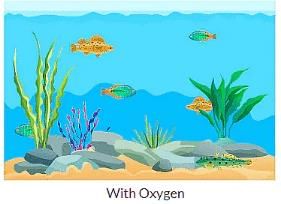
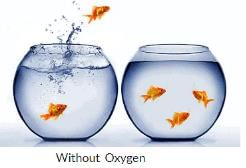
As a result, the amount of air dissolved in the water can get reduced. If all the air was used up, the fish would die.- a)Buy some more fishes for him
- b)Remove the cover from fishes bowl
- c)Advise him to put some food
- d)Both (b) and (c)
Correct answer is option 'D'. Can you explain this answer?
Ramu kept some fishes in the bowl and filled the fish bowl with water. Then he covered it from the top and forget to add food into the fish bowl. After few days, he noticed that few of the fishes stopped moving. He started crying. As a friends, how will you stop Ramu from crying?


As a result, the amount of air dissolved in the water can get reduced. If all the air was used up, the fish would die.


As a result, the amount of air dissolved in the water can get reduced. If all the air was used up, the fish would die.
a)
Buy some more fishes for him
b)
Remove the cover from fishes bowl
c)
Advise him to put some food
d)
Both (b) and (c)
|
|
Amit Khanna answered |
Because fishes are living things and they need oxygen to breathe and food to survive.
Which of these row refers only to non-living things.- a)Clouds, fire, wood, pencil
- b)Birds, trees, woman, girl
- c)Television, leaves, boy, rose
- d)Clouds, Rivers, Paper, tree
Correct answer is option 'A'. Can you explain this answer?
Which of these row refers only to non-living things.
a)
Clouds, fire, wood, pencil
b)
Birds, trees, woman, girl
c)
Television, leaves, boy, rose
d)
Clouds, Rivers, Paper, tree
|
|
Manish Kapoor answered |
Clouds, fire wood, pencil all are non-living things.
Living things can only be:- a)Natural
- b)Artificial
- c)Man-made
- d)All of these
Correct answer is option 'A'. Can you explain this answer?
Living things can only be:
a)
Natural
b)
Artificial
c)
Man-made
d)
All of these
|
|
Saumya Yadav answered |
Living things can only be natural
Living things are organisms that possess the characteristics of life, such as the ability to grow, reproduce, respond to stimuli, and maintain homeostasis. These organisms can be found in various habitats on Earth, ranging from the depths of the oceans to the highest mountaintops. However, when it comes to categorizing living things, the correct answer is option 'A', which states that living things can only be natural.
Explanation
1. Natural vs. Artificial
Living things can be classified into two broad categories: natural and artificial.
- Natural: Natural organisms are those that occur in nature and have not been created or modified by humans. They have evolved through natural processes over millions of years. Examples of natural living things include plants, animals, fungi, and microorganisms like bacteria and viruses.
- Artificial: Artificial organisms are those that have been created or modified by humans through genetic engineering or other artificial means. These organisms do not occur naturally and have been developed for specific purposes, such as genetically modified crops or laboratory-grown tissues.
2. Man-made vs. Natural
The term "man-made" is often used interchangeably with "artificial" to refer to things created by humans. However, it is important to note that living things cannot be man-made. While humans can manipulate the genetic material of organisms to create genetically modified organisms (GMOs), these organisms are still considered natural because they are derived from existing living things.
3. Characteristics of Living Things
Living things possess certain characteristics that distinguish them from non-living things. These characteristics include:
- Cellular organization: Living things are composed of one or more cells, which are the basic structural and functional units of life.
- Growth and development: Living things have the ability to grow and develop, increasing in size and complexity over time.
- Reproduction: Living things can reproduce, producing offspring that inherit their genetic traits.
- Homeostasis: Living things maintain a stable internal environment despite changes in their external environment.
- Metabolism: Living things carry out various chemical reactions to obtain and use energy.
- Response to stimuli: Living things can respond to stimuli from their environment, such as light, temperature, or touch.
Conclusion
In conclusion, living things can only be natural. While humans can create or modify organisms through genetic engineering, these organisms are still considered natural because they are derived from existing living things. Living things possess certain characteristics that distinguish them from non-living things, such as cellular organization, growth and development, reproduction, homeostasis, metabolism, and response to stimuli.
Living things are organisms that possess the characteristics of life, such as the ability to grow, reproduce, respond to stimuli, and maintain homeostasis. These organisms can be found in various habitats on Earth, ranging from the depths of the oceans to the highest mountaintops. However, when it comes to categorizing living things, the correct answer is option 'A', which states that living things can only be natural.
Explanation
1. Natural vs. Artificial
Living things can be classified into two broad categories: natural and artificial.
- Natural: Natural organisms are those that occur in nature and have not been created or modified by humans. They have evolved through natural processes over millions of years. Examples of natural living things include plants, animals, fungi, and microorganisms like bacteria and viruses.
- Artificial: Artificial organisms are those that have been created or modified by humans through genetic engineering or other artificial means. These organisms do not occur naturally and have been developed for specific purposes, such as genetically modified crops or laboratory-grown tissues.
2. Man-made vs. Natural
The term "man-made" is often used interchangeably with "artificial" to refer to things created by humans. However, it is important to note that living things cannot be man-made. While humans can manipulate the genetic material of organisms to create genetically modified organisms (GMOs), these organisms are still considered natural because they are derived from existing living things.
3. Characteristics of Living Things
Living things possess certain characteristics that distinguish them from non-living things. These characteristics include:
- Cellular organization: Living things are composed of one or more cells, which are the basic structural and functional units of life.
- Growth and development: Living things have the ability to grow and develop, increasing in size and complexity over time.
- Reproduction: Living things can reproduce, producing offspring that inherit their genetic traits.
- Homeostasis: Living things maintain a stable internal environment despite changes in their external environment.
- Metabolism: Living things carry out various chemical reactions to obtain and use energy.
- Response to stimuli: Living things can respond to stimuli from their environment, such as light, temperature, or touch.
Conclusion
In conclusion, living things can only be natural. While humans can create or modify organisms through genetic engineering, these organisms are still considered natural because they are derived from existing living things. Living things possess certain characteristics that distinguish them from non-living things, such as cellular organization, growth and development, reproduction, homeostasis, metabolism, and response to stimuli.
Which of the following represents growth in living things?- a)A balloon increasing in size when inflated.
- b)A gel bead increasing in size when put in water.
- c)Money plant spreading on wall.
- d)None of these.
Correct answer is option 'C'. Can you explain this answer?
Which of the following represents growth in living things?
a)
A balloon increasing in size when inflated.
b)
A gel bead increasing in size when put in water.
c)
Money plant spreading on wall.
d)
None of these.
|
|
Swati Chavan answered |
Growth in Living Things
Living things are organisms that have the ability to grow, reproduce, and respond to their environment. Growth is an essential characteristic of living things and is a result of cell division and cell enlargement. Here are some examples of growth in living things:
Money Plant Spreading on Wall
Money plant is a popular indoor plant that is easy to grow and maintain. It is known for its ability to grow quickly and spread on walls. The growth of money plant is a result of cell division and cell enlargement. When the plant receives enough water and nutrients, it grows new leaves and stems, which help it climb up the wall. As the plant grows, it forms new roots that attach to the wall and absorb water and nutrients from the soil. This allows the plant to continue growing and spreading. The growth of money plant is a good example of how living things can adapt to their environment and use their resources to grow and thrive.
A Balloon Increasing in Size When Inflated
A balloon is not a living thing, but it can increase in size when inflated. This is because the balloon is made of a flexible material that can stretch when air is pumped into it. The increase in size is not a result of cell division or cell enlargement, but rather a physical change in the material of the balloon.
A Gel Bead Increasing in Size When Put in Water
Gel beads are small, water-absorbent spheres that are often used in flower arrangements and as a sensory toy. When gel beads are put in water, they absorb the water and increase in size. The increase in size is not a result of cell division or cell enlargement, but rather a physical change in the material of the gel beads.
Conclusion
In conclusion, growth in living things is a result of cell division and cell enlargement. Money plant spreading on the wall is a good example of growth in living things, while a balloon increasing in size when inflated and a gel bead increasing in size when put in water are examples of physical changes in non-living things.
Living things are organisms that have the ability to grow, reproduce, and respond to their environment. Growth is an essential characteristic of living things and is a result of cell division and cell enlargement. Here are some examples of growth in living things:
Money Plant Spreading on Wall
Money plant is a popular indoor plant that is easy to grow and maintain. It is known for its ability to grow quickly and spread on walls. The growth of money plant is a result of cell division and cell enlargement. When the plant receives enough water and nutrients, it grows new leaves and stems, which help it climb up the wall. As the plant grows, it forms new roots that attach to the wall and absorb water and nutrients from the soil. This allows the plant to continue growing and spreading. The growth of money plant is a good example of how living things can adapt to their environment and use their resources to grow and thrive.
A Balloon Increasing in Size When Inflated
A balloon is not a living thing, but it can increase in size when inflated. This is because the balloon is made of a flexible material that can stretch when air is pumped into it. The increase in size is not a result of cell division or cell enlargement, but rather a physical change in the material of the balloon.
A Gel Bead Increasing in Size When Put in Water
Gel beads are small, water-absorbent spheres that are often used in flower arrangements and as a sensory toy. When gel beads are put in water, they absorb the water and increase in size. The increase in size is not a result of cell division or cell enlargement, but rather a physical change in the material of the gel beads.
Conclusion
In conclusion, growth in living things is a result of cell division and cell enlargement. Money plant spreading on the wall is a good example of growth in living things, while a balloon increasing in size when inflated and a gel bead increasing in size when put in water are examples of physical changes in non-living things.
All living things need ____ to drink and ____ to breathe.- a)Water and oil
- b)Air and milk
- c)Water and air
- d)Food and air
Correct answer is option 'C'. Can you explain this answer?
All living things need ____ to drink and ____ to breathe.
a)
Water and oil
b)
Air and milk
c)
Water and air
d)
Food and air
|
|
Debolina Joshi answered |
Introduction:
All living things require certain essential elements to survive and carry out their life processes. Two of the most fundamental needs of living things are water and air. Water is necessary for hydration and various physiological processes, while air provides the oxygen required for respiration.
Main Body:
Water:
- Water is an essential component of all living organisms. It plays a vital role in maintaining bodily functions and survival.
- Plants use water for photosynthesis, a process that enables them to produce food and energy.
- Animals need water to stay hydrated, regulate body temperature, and facilitate digestion.
- Water is also crucial for the transportation of nutrients, waste removal, and lubrication of joints.
Air:
- Air, specifically the oxygen it contains, is essential for respiration, the process by which living organisms obtain energy from food.
- Plants use carbon dioxide from the air and release oxygen through the process of photosynthesis.
- Animals inhale oxygen from the air and exhale carbon dioxide, which is a waste product of cellular respiration.
- Oxygen is necessary for the production of energy through the breakdown of glucose in the presence of oxygen.
Importance of water and air:
- Without water, living organisms would not be able to carry out their vital functions and would ultimately die of dehydration.
- Without air, living organisms would not be able to respire and obtain the energy required for growth, reproduction, and other life processes.
- Both water and air are essential for the survival and well-being of all living things, from microscopic single-celled organisms to complex multicellular organisms.
Conclusion:
In conclusion, all living things require water to drink and air to breathe. Water provides hydration and supports various physiological processes, while air supplies the oxygen necessary for respiration and energy production. These two fundamental needs are essential for the survival and functioning of all living organisms.
All living things require certain essential elements to survive and carry out their life processes. Two of the most fundamental needs of living things are water and air. Water is necessary for hydration and various physiological processes, while air provides the oxygen required for respiration.
Main Body:
Water:
- Water is an essential component of all living organisms. It plays a vital role in maintaining bodily functions and survival.
- Plants use water for photosynthesis, a process that enables them to produce food and energy.
- Animals need water to stay hydrated, regulate body temperature, and facilitate digestion.
- Water is also crucial for the transportation of nutrients, waste removal, and lubrication of joints.
Air:
- Air, specifically the oxygen it contains, is essential for respiration, the process by which living organisms obtain energy from food.
- Plants use carbon dioxide from the air and release oxygen through the process of photosynthesis.
- Animals inhale oxygen from the air and exhale carbon dioxide, which is a waste product of cellular respiration.
- Oxygen is necessary for the production of energy through the breakdown of glucose in the presence of oxygen.
Importance of water and air:
- Without water, living organisms would not be able to carry out their vital functions and would ultimately die of dehydration.
- Without air, living organisms would not be able to respire and obtain the energy required for growth, reproduction, and other life processes.
- Both water and air are essential for the survival and well-being of all living things, from microscopic single-celled organisms to complex multicellular organisms.
Conclusion:
In conclusion, all living things require water to drink and air to breathe. Water provides hydration and supports various physiological processes, while air supplies the oxygen necessary for respiration and energy production. These two fundamental needs are essential for the survival and functioning of all living organisms.
Which of the following process is not shown by the given process. What does the above diagram does not do: 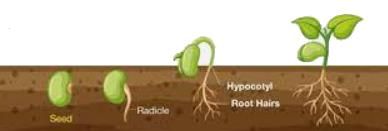
- a)Grow
- b)Respire
- c)Breathe
- d)move
Correct answer is option 'D'. Can you explain this answer?
Which of the following process is not shown by the given process. What does the above diagram does not do:

a)
Grow
b)
Respire
c)
Breathe
d)
move
|
|
Pranav Singh answered |
The above diagram shows the process of germination in plants. And Plants do not move.
A grasshopper with some leaves is placed in a glass jar, The jar is tightly closed with a lid.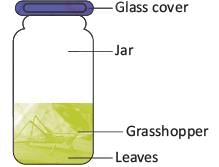 The grasshopper will die because there is no ____ in the glass jar.
The grasshopper will die because there is no ____ in the glass jar.- a)food
- b)air
- c)light
- d)water
Correct answer is option 'B'. Can you explain this answer?
A grasshopper with some leaves is placed in a glass jar, The jar is tightly closed with a lid.

The grasshopper will die because there is no ____ in the glass jar.
a)
food
b)
air
c)
light
d)
water
|
|
Stoneridge Institute answered |
In the given scenario, the grasshopper is placed in a tightly closed jar, meaning that air cannot enter the jar. Grasshoppers, like all animals, require oxygen from the air to breathe. Without air, the grasshopper will suffocate and eventually die.
Thus, the grasshopper will die because there is no air in the glass jar.
Therefore, the correct answer is B: air.
Direction: Fill in the blanks in the passage given:Q. The things which have life in them are called ____ things. For example birds have life and they can ____. Living things can ____ as birds lay eggs. Non-living things cannot ____ on their own. Some of the non-living things like water, wood and rock are ____ things.- a)Living, move, reproduce, move, Non-living.
- b)Rock, Non-living, grow, fell, speaks.
- c)Feel, reproduce, live, living, lay.
- d)Move, Breathe, Grow, living cannot.
Correct answer is option 'A'. Can you explain this answer?
Direction: Fill in the blanks in the passage given:
Q. The things which have life in them are called ____ things. For example birds have life and they can ____. Living things can ____ as birds lay eggs. Non-living things cannot ____ on their own. Some of the non-living things like water, wood and rock are ____ things.
a)
Living, move, reproduce, move, Non-living.
b)
Rock, Non-living, grow, fell, speaks.
c)
Feel, reproduce, live, living, lay.
d)
Move, Breathe, Grow, living cannot.
|
|
Amit Khanna answered |
Living things can move, reproduce, grow but non living things cannot.
What does a plant need for healthy growth- a)A glass of water
- b)Plenty of water
- c)The right amount of water
- d)None
Correct answer is option 'C'. Can you explain this answer?
What does a plant need for healthy growth
a)
A glass of water
b)
Plenty of water
c)
The right amount of water
d)
None

|
Kds Coaching answered |
What does a plant need for healthy growth?
There are several key factors that contribute to the healthy growth of plants. These include:
1. Sunlight:
- Plants need sunlight to carry out photosynthesis, a process that converts sunlight into energy for growth.
- Sunlight provides plants with the necessary energy to produce food and nutrients.
2. Water:
- Water is essential for plant growth as it is involved in various physiological processes.
- It helps transport nutrients from the soil to different parts of the plant and maintains turgidity.
- The right amount of water is crucial for plant health; too little or too much can adversely affect growth.
3. Nutrients:
- Plants require a range of essential nutrients such as nitrogen, phosphorus, and potassium for healthy growth.
- These nutrients are obtained from the soil and are necessary for various plant functions, including cell division, photosynthesis, and root development.
4. Soil:
- The quality and composition of the soil play a significant role in plant growth.
- Good soil should provide proper drainage, sufficient aeration, and the necessary nutrients for plants to thrive.
5. Temperature:
- Different plants have specific temperature requirements for optimal growth.
- Extreme temperatures, either too hot or too cold, can hinder the growth and development of plants.
6. Air:
- Adequate air circulation is crucial for plant growth as it helps in the exchange of gases.
- Plants require carbon dioxide for photosynthesis and oxygen for respiration.
7. Space:
- Sufficient space is essential for plants to grow and spread their roots.
- Overcrowding can lead to competition for resources and hinder healthy growth.
Conclusion:
To ensure healthy plant growth, it is important to provide plants with the right amount of sunlight, water, nutrients, suitable soil conditions, appropriate temperature, proper air circulation, and sufficient space. By meeting these requirements, plants can thrive and reach their full potential.
There are several key factors that contribute to the healthy growth of plants. These include:
1. Sunlight:
- Plants need sunlight to carry out photosynthesis, a process that converts sunlight into energy for growth.
- Sunlight provides plants with the necessary energy to produce food and nutrients.
2. Water:
- Water is essential for plant growth as it is involved in various physiological processes.
- It helps transport nutrients from the soil to different parts of the plant and maintains turgidity.
- The right amount of water is crucial for plant health; too little or too much can adversely affect growth.
3. Nutrients:
- Plants require a range of essential nutrients such as nitrogen, phosphorus, and potassium for healthy growth.
- These nutrients are obtained from the soil and are necessary for various plant functions, including cell division, photosynthesis, and root development.
4. Soil:
- The quality and composition of the soil play a significant role in plant growth.
- Good soil should provide proper drainage, sufficient aeration, and the necessary nutrients for plants to thrive.
5. Temperature:
- Different plants have specific temperature requirements for optimal growth.
- Extreme temperatures, either too hot or too cold, can hinder the growth and development of plants.
6. Air:
- Adequate air circulation is crucial for plant growth as it helps in the exchange of gases.
- Plants require carbon dioxide for photosynthesis and oxygen for respiration.
7. Space:
- Sufficient space is essential for plants to grow and spread their roots.
- Overcrowding can lead to competition for resources and hinder healthy growth.
Conclusion:
To ensure healthy plant growth, it is important to provide plants with the right amount of sunlight, water, nutrients, suitable soil conditions, appropriate temperature, proper air circulation, and sufficient space. By meeting these requirements, plants can thrive and reach their full potential.
A bird can______ but a table can not.- a)crawl
- b)fly
- c)glide
- d)both (b) and (c)
Correct answer is option 'D'. Can you explain this answer?
A bird can______ but a table can not.
a)
crawl
b)
fly
c)
glide
d)
both (b) and (c)
|
|
Manish Kapoor answered |
A bird is a living thing so it can move by flying. But it can glide also, a table is a non living thing and it can not move.
What does the above picture do:
- a)It grows
- b)It moves
- c)It reprodueces
- d)It breathes
Correct answer is option 'B'. Can you explain this answer?
What does the above picture do:

a)
It grows
b)
It moves
c)
It reprodueces
d)
It breathes
|
|
Manish Kapoor answered |
The above picture is of a cloud. It can move.
For which of the following image breathing is must to survive?- a)

- b)

- c)

- d)

Correct answer is option 'C'. Can you explain this answer?
For which of the following image breathing is must to survive?
a)

b)

c)

d)

|
|
Pranav Singh answered |
Bear need oxygen to breathe because without it the bear will die.
Which of the following is a man-made non-living thing?- a)Tree
- b)Ship
- c)Rock
- d)Monkey
Correct answer is option 'B'. Can you explain this answer?
Which of the following is a man-made non-living thing?
a)
Tree
b)
Ship
c)
Rock
d)
Monkey
|
|
Amit Khanna answered |
Ship is a man-made non-living thing.
Unscramble the words on the train, which of them is man-made?

- a)Elephant
- b)Pencil
- c)Tree
- d)Sun
Correct answer is option 'B'. Can you explain this answer?
Unscramble the words on the train, which of them is man-made?


a)
Elephant
b)
Pencil
c)
Tree
d)
Sun
|
|
Edgy Education answered |
The man-made things in the above list are cup, pencil and train.
Which of the following non living thing can move from one place to another?- a)

- b)

- c)

- d)

Correct answer is option 'C'. Can you explain this answer?
Which of the following non living thing can move from one place to another?
a)

b)

c)

d)

|
|
Manish Kapoor answered |
A car is a non living thing so it can not move but if we put petrol in it, it will move with the help of Petrol.
Which of the following is a living thing?- a)

- b)

- c)
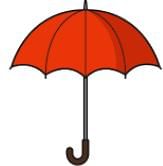
- d)

Correct answer is option 'B'. Can you explain this answer?
Which of the following is a living thing?
a)

b)

c)

d)

|
|
Glitz Classes answered |
Living Things in the Given Options:
A: The first option is an image of a non-living object, which appears to be a piece of machinery. It does not meet the criteria of a living thing as it does not exhibit characteristics such as growth, reproduction, or response to stimuli.
B: This option is an image of a plant. Plants are living things as they exhibit characteristics of life such as growth, reproduction, and response to stimuli. They also require energy, have cells, and undergo metabolic processes.
C: The third option is an image of a non-living object, which appears to be a piece of artwork or sculpture. It does not meet the criteria of a living thing as it lacks the necessary characteristics mentioned above.
D: The fourth option is an image of a non-living object, which appears to be a man-made structure or monument. Similar to the previous options, it does not exhibit the characteristics of a living thing.
Therefore, the correct answer is B: the image of the plant.
A: The first option is an image of a non-living object, which appears to be a piece of machinery. It does not meet the criteria of a living thing as it does not exhibit characteristics such as growth, reproduction, or response to stimuli.
B: This option is an image of a plant. Plants are living things as they exhibit characteristics of life such as growth, reproduction, and response to stimuli. They also require energy, have cells, and undergo metabolic processes.
C: The third option is an image of a non-living object, which appears to be a piece of artwork or sculpture. It does not meet the criteria of a living thing as it lacks the necessary characteristics mentioned above.
D: The fourth option is an image of a non-living object, which appears to be a man-made structure or monument. Similar to the previous options, it does not exhibit the characteristics of a living thing.
Therefore, the correct answer is B: the image of the plant.
Plant make their food from air, water and ____.- a)Moon light
- b)Sunlight
- c)Salts
- d)Both (a) and (b)
Correct answer is option 'B'. Can you explain this answer?
Plant make their food from air, water and ____.
a)
Moon light
b)
Sunlight
c)
Salts
d)
Both (a) and (b)
|
|
Manish Kapoor answered |
Plants need sunlight to make their food. And this process is termed as photosynthesis.
Which of the following cannot move by itself?- a)

- b)

- c)

- d)

Correct answer is option 'D'. Can you explain this answer?
Which of the following cannot move by itself?
a)

b)

c)

d)

|
|
Pranav Singh answered |
Flower cannot move by itself some one carries it from one place to other.
Find the odd one out:
Sun, Wings, Gills, Nose- a)Wings
- b)Sun
- c)Nose
- d)Gills
Correct answer is option 'B'. Can you explain this answer?
Find the odd one out:
Sun, Wings, Gills, Nose
Sun, Wings, Gills, Nose
a)
Wings
b)
Sun
c)
Nose
d)
Gills
|
|
Stoneridge Institute answered |
To find the odd one out, we need to identify the word that does not belong to the same category as the others. Let's analyze each option:
A: Wings
- Wings are a characteristic of birds and some insects. They are used for flying.
- All other options do not relate to the concept of flight or wings.
B: Sun
- The Sun is a celestial body that emits light and heat. It is part of our solar system.
- All other options are features or body parts of living organisms.
C: Nose
- The nose is a facial feature that is used for smelling and breathing.
- All other options are either related to body parts used for locomotion (wings) or respiration (gills).
D: Gills
- Gills are respiratory organs found in aquatic animals, such as fish. They enable them to extract oxygen from water.
- All other options are either related to body parts used for locomotion (wings) or smelling/breathing (nose).
Based on the analysis above, the odd one out is B: Sun. It does not belong to the same category as the other options, which are all related to living organisms and their body parts.
Study the given classification table. Select the Incorrect option regarding it.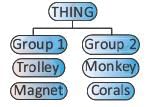
- a)A fish should be placed in group 2.
- b)A pearl oyster should be placed in group 2.
- c)A toy car should be place in group 1.
- d)A newspaper should be placed in group 2.
Correct answer is option 'D'. Can you explain this answer?
Study the given classification table. Select the Incorrect option regarding it.

a)
A fish should be placed in group 2.
b)
A pearl oyster should be placed in group 2.
c)
A toy car should be place in group 1.
d)
A newspaper should be placed in group 2.

|
Gunjan Lakhani answered |
all non living things are in group 1 and living things are in group 2
News paper is a non living thing and cannot be added in living thing ie (group 2).
Which of these is a non-living?
- a)Boy
- b)A table
- c)A snake
- d)A monkey
Correct answer is option 'B'. Can you explain this answer?
Which of these is a non-living?
a)
Boy
b)
A table
c)
A snake
d)
A monkey
|
|
Anjana choudhary answered |
Reproduction in Living Things
Reproduction is the process by which living organisms produce offspring of their own kind. It is an essential characteristic of all living things, ensuring the continuation of their species. There are different ways in which living things reproduce, including laying eggs, giving birth to live young, and producing seeds. Let's explore these methods in more detail.
**Laying Eggs:**
- Many animals, such as birds, reptiles, and insects, reproduce by laying eggs.
- These animals typically have a specialized reproductive organ called an ovary that produces eggs.
- The eggs are then fertilized either internally or externally, depending on the species.
- Once fertilized, the eggs are laid in a suitable environment where they develop and eventually hatch into offspring.
**Having Babies:**
- Some animals, including mammals like humans, give birth to live young.
- In these animals, the female's reproductive system contains specialized organs such as ovaries, fallopian tubes, and a uterus.
- The eggs are produced in the ovaries, and once fertilized by sperm, they travel through the fallopian tubes to the uterus, where they develop into embryos.
- The embryos receive nutrients and support from the mother's body until they are fully developed and ready to be born.
**Producing Seeds:**
- Plants reproduce by producing seeds, which contain the embryo of a new plant.
- The male reproductive organ in plants is the stamen, which produces pollen.
- The female reproductive organ is the pistil, which contains the ovary where the seeds develop.
- Pollination occurs when pollen is transferred from the stamen to the pistil, either by wind, insects, or other animals.
- The fertilized ovules within the ovary develop into seeds, which can then be dispersed and germinate into new plants.
In conclusion, all living things have the ability to reproduce, but the methods they use can vary. Some lay eggs, some give birth to live young, and others produce seeds. Reproduction ensures the survival and continuation of each species, allowing them to adapt and evolve over time.
Reproduction is the process by which living organisms produce offspring of their own kind. It is an essential characteristic of all living things, ensuring the continuation of their species. There are different ways in which living things reproduce, including laying eggs, giving birth to live young, and producing seeds. Let's explore these methods in more detail.
**Laying Eggs:**
- Many animals, such as birds, reptiles, and insects, reproduce by laying eggs.
- These animals typically have a specialized reproductive organ called an ovary that produces eggs.
- The eggs are then fertilized either internally or externally, depending on the species.
- Once fertilized, the eggs are laid in a suitable environment where they develop and eventually hatch into offspring.
**Having Babies:**
- Some animals, including mammals like humans, give birth to live young.
- In these animals, the female's reproductive system contains specialized organs such as ovaries, fallopian tubes, and a uterus.
- The eggs are produced in the ovaries, and once fertilized by sperm, they travel through the fallopian tubes to the uterus, where they develop into embryos.
- The embryos receive nutrients and support from the mother's body until they are fully developed and ready to be born.
**Producing Seeds:**
- Plants reproduce by producing seeds, which contain the embryo of a new plant.
- The male reproductive organ in plants is the stamen, which produces pollen.
- The female reproductive organ is the pistil, which contains the ovary where the seeds develop.
- Pollination occurs when pollen is transferred from the stamen to the pistil, either by wind, insects, or other animals.
- The fertilized ovules within the ovary develop into seeds, which can then be dispersed and germinate into new plants.
In conclusion, all living things have the ability to reproduce, but the methods they use can vary. Some lay eggs, some give birth to live young, and others produce seeds. Reproduction ensures the survival and continuation of each species, allowing them to adapt and evolve over time.
All living things have longer than others.- a)change
- b)lifespan
- c)grow
- d)energy
Correct answer is option 'B'. Can you explain this answer?
All living things have longer than others.
a)
change
b)
lifespan
c)
grow
d)
energy
|
|
Stoneridge Institute answered |
Statement: All living things have longer than others.
Explanation:
- The statement implies that some living things have a longer lifespan compared to others.
- We need to identify the word that means "lifespan" in order to choose the correct answer.
Options:
A:
change
B:
lifespan
C:
grow
D:
energy
Analysis:
- Option A, "change," does not directly relate to the concept of lifespan, so it can be eliminated.
- Option B, "lifespan," is the correct answer as it directly correlates with the meaning of the statement.
- Option C, "grow," is not directly related to lifespan and can be eliminated.
- Option D, "energy," does not directly relate to lifespan and can be eliminated.
Conclusion:
The correct answer is B:
lifespan
. This word accurately represents the concept of living things having different lengths of life.Which one of the following can grow?- a)

- b)

- c)

- d)

Correct answer is option 'D'. Can you explain this answer?
Which one of the following can grow?
a)

b)

c)

d)

|
|
Pranav Singh answered |
Frog is living thing and grow as well as reproduce.
Which of the following move from place to place?- a)Stone
- b)Leaf
- c)Dog
- d)Chair
Correct answer is option 'C'. Can you explain this answer?
Which of the following move from place to place?
a)
Stone
b)
Leaf
c)
Dog
d)
Chair

|
Kds Coaching answered |
Answer:
The following options move from place to place:
A: Stone
- Stones do not have the ability to move from place to place on their own. They are stationary objects and cannot change their location without external force.
B: Leaf
- Leaves are typically attached to plants and trees. While they may move in the wind, they do not have the ability to actively move from place to place.
C: Dog
- Dogs are living beings and have the ability to move from place to place. They can walk, run, and explore different locations.
D: Chair
- Chairs are inanimate objects and do not have the ability to move from place to place on their own. They require human or external force to be moved.
Conclusion:
Based on the given options, the only item that can move from place to place is a dog (Option C). Dogs have the ability to walk and run, allowing them to change their location.
The following options move from place to place:
A: Stone
- Stones do not have the ability to move from place to place on their own. They are stationary objects and cannot change their location without external force.
B: Leaf
- Leaves are typically attached to plants and trees. While they may move in the wind, they do not have the ability to actively move from place to place.
C: Dog
- Dogs are living beings and have the ability to move from place to place. They can walk, run, and explore different locations.
D: Chair
- Chairs are inanimate objects and do not have the ability to move from place to place on their own. They require human or external force to be moved.
Conclusion:
Based on the given options, the only item that can move from place to place is a dog (Option C). Dogs have the ability to walk and run, allowing them to change their location.
Chapter doubts & questions for Living Things and Their Growth - Science & Technology for Grade 1 2025 is part of Grade 1 exam preparation. The chapters have been prepared according to the Grade 1 exam syllabus. The Chapter doubts & questions, notes, tests & MCQs are made for Grade 1 2025 Exam. Find important definitions, questions, notes, meanings, examples, exercises, MCQs and online tests here.
Chapter doubts & questions of Living Things and Their Growth - Science & Technology for Grade 1 in English & Hindi are available as part of Grade 1 exam.
Download more important topics, notes, lectures and mock test series for Grade 1 Exam by signing up for free.
Science & Technology for Grade 1
11 videos|140 docs|37 tests
|

Contact Support
Our team is online on weekdays between 10 AM - 7 PM
Typical reply within 3 hours
|
Free Exam Preparation
at your Fingertips!
Access Free Study Material - Test Series, Structured Courses, Free Videos & Study Notes and Prepare for Your Exam With Ease

 Join the 10M+ students on EduRev
Join the 10M+ students on EduRev
|

|
Create your account for free
OR
Forgot Password
OR
Signup on EduRev and stay on top of your study goals
10M+ students crushing their study goals daily

